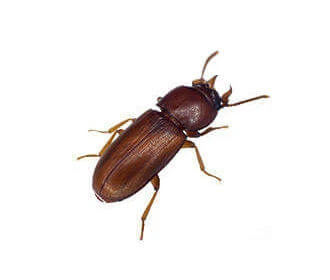For your Home
Login or register for the customer portal
Pests found in food covers a large variety of insects, including beetles and moths.
Learn more below about common species of Stored Product Insects (SPIs) found in the U.S.
Don't waste time, book a treatment now with one of our experts

(Acanthoscelides obtectus)

(Various species - Liposcelis bostrychophila, Lepinotus patruelis)

(Gnatocerus Cornutus)
An approximate 3.5 – 4.5mm in length, male broadhorned beetles have two enlarged mandibles on the head, giving the appearance of horns and thus their name. Females are very similar in appearance to the confused flour beetle.
With temperature limits of 60-90°F, broadhorned flour beetles cannot complete their life cycle below 50°F.
Feeds on flour, dough, semolina etc. Moth eggs and larvae may supplement the broadhorned flour beetle diet.

Cheese mites have soft, hairy cream white bodies with 8 hairless legs and adults grow up to an approximate 0.5mm in length.
The cheese mite favors warm, moist conditions and eggs mature in 10 days at room temperatures. Females can lay up to 900 eggs in a lifetime at a rate of 20 – 30 a day. Adult cheese mites can live for up to 60 – 70 days.
With a preference for old cheese to young cheese, these mites also feed on nuts, dried eggs, fruit, flour and tobacco. Cheese mites are capable of contaminating foods to cause skin or gut irritation.

(Lasioderma serricorne)
The Cigarette beetle is a very common commercial pest.

(Araecerus Fasciculatus)

(Tribolium Confusum)
The confused flour beetle was named because of the confusion over its identity. It is a very common commercial and pantry pest.

(Necrobia Rufipes)

(Dermestes beetle)

(Stegobium Paniceum)
The drugstore beetle (also known as the Biscuit Beetle) gained its name because it was frequently found feeding on drugs in pharmacies many years ago. Now, they are customarily found infesting all types of dry stored food products, spices, seeds, grains and dried plant material.

(Cryptolestes Ferrugineus)

(Acarus siro)

(Ahasverus advena)
It is frequently associated with hot spots in farm-stored grain. Although primarily a fungivorous species. The presence of this insect in farm-stored grain is taken as a warning that the grain is beginning to spoil and become moldy.

(Attagenus pellio)

(Glycyphagus domesticus)

(Niptus hololeucus)

(Prostephanus Truncatus)

(Sitophilus Granarius)
The Granary Weevil is among the most destructive of all stored grain insects. The larvae develop inside kernels of whole grain in storage. This makes an infestation difficult to remove in the milling process.

(Plodia Interpunctella)
The Indian meal moth larva's is a very common commercial and pantry pest.

(Dermestes lardarius)

(Dermestes maculatus)

(Rhyzopertha dominica)
This beetle lives and feeds in warehouses and stores, especially feed and health food stores.

(Alphitobius diaperinus)

(Sitophilus zaemais)
Also known as the Greater Rice Weevil. Maize Weevils are frequently regarded as primary pests of grain since they are able to infest otherwise undamaged grain.
They have also been seen to infest buckwheat, peas, acorns, chestnuts and cottonseed.

(Oryzaephilus Mercator)
Merchant grain beetles are found in pantries or in food processing areas or warehouses.

(Ephestia kuehniella)
The Mediterranean flour moth larva is a very common commercial and pantry pest. It is a pest of mills and warehouses as it can clog machinery with its webs.

(Sitophilus Oryzae)
Rice weevils are pests of stored grain and seeds.

(Paederus riparius)

(Tribolium castaneum)
Is a very common commercial pest infesting a variety of grain and food materials. The rust-red flour beetle is frequently found in stored products in the U.S.

(Oryzaephilus Surinamensis)
The sawtoothed grain beetle is a common stored product pest found throughout the United States in homes, grocery stores, food warehouses, and grain storage facilities. Similar in appearance to the merchant grain beetle, the merchant grain beetle has the ability to fly, while the sawtoothed grain beetle does not. Adults find their way into stored grains, flour, sugar, nuts, and other dry material of plant origin through cracks and crevices of imperfectly sealed containers. They are incapable of attacking sound grain kernels and often occur in food previously infested by other stored product pests. Their flattened body allows them to easily penetrate broken kernels of grain and packaged materials. Not only do they contaminate food, they often cause mold problems due to moisture build-up.

(Gibbium psylloides)

(Ephestia Elutella)
The Tobacco Moth is an introduced pest species of moth. Often found in warehouses and other areas where food or tobacco is stored.

(Trogoderma variabile)

(Ptinus fur)

(Tenebrio molitor)
Find us on social media to stay up to date with the latest pest news and industry-leading pest prevention tips.